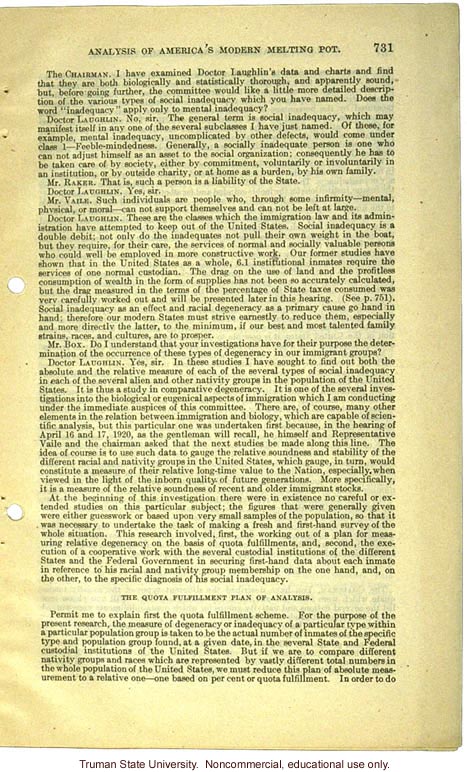Analysis of America's Melting Pot 731
The Chairman. I have examined Dr. Laughlin's data and charts and find that they are both biologically and statistically thorough, and apparently sound, but, before going further, the committee would like a little more detailed description of the various types of social inadequacy, which you have named. Does the word "inadequacy" apply only to mental inadequacy?
Doctor Laughlin. No, sir. The general term is social inadequacy, which may manifest itself in any one of several subclasses I have just named. Of those, for example, mental inadequacy, uncomplicated by other defects, would come under class I - Feeble-mindedness. Generally, a socially inadequate person is one who can not adjust himself as an asset to the social organization; consequently he has to be taken care of by society, either by commitment, voluntarily or involuntarily in an institution, or by outside charity, or at home as a burden, by his own family.
Mr. Raker. That is, such a person is a liability of the State.
Doctor Laughlin. Yes, sir.
Mr. Vaile. Such individuals are people who, through some infirmity -- mental, physical, or moral - can not support themselves and can not be left at large.
Doctor Laughlin. These are the classes which the immigration law and its administration have attempted to keep out of the United States . Social inadequacy is a double debit; not only do the inadequates not pull their own weight in the boat, but they require, for their care, the services of normal and socially valuable persons who could well be employed in more constructive work. Our former studies have shown that in the United States as a whole, 6.1 institutional inmates require the services of one normal custodian. The drag on the use of land and the profitless consumption of wealth in the form of supplies has not been so accurately calculated, but the drag measured in the terms of the percentage of State taxes consumed was very carefully worked out and will be presented later in this hearing. (See p. 751). Social inadequacy as an effect and racial degeneracy as a primary cause go hand in hand; therefore our modern States must strive earnestly to reduce them, especially and more directly the latter, to the minimum, if our best and most talented family strains, races, and cultures are to prosper.
Mr. Box. Do I understand that your investigations have for their purpose the determination of the occurrence of these types of degeneracy in our immigrant groups?
Doctor Laughlin. Yes, sir. In these studies I have sought to find out both the absolute and the relative measure of each of the several types of social inadequacy in each of the several alien and other nativity groups in the population of the United States. It is thus a study in comparative degeneracy. It is one of the several investigations in the biological or eugenical aspects of immigration which I am conducting under the immediate auspices of this committee. There are, of course, many other elements in the relation between immigration and biology, which are capable of scientific analysis, but this particular one was undertaken first because, in the hearing of April 16 and 17, 1920, as the gentlemen will recall, he himself and the Representatives Vaile and the chairman asked that the next studies be made along this line. The idea of course is to use such data to gauge the relative soundness and stability of the different racial and nativity groups in the United States, which gauge, in turn, would constitute a measure of their relative long-time value to the Nation, especially, when viewed in the light of the inborn quality of future generations. More specifically, it is a measure of the relative soundness of recent and older immigrant stocks.
At the beginning of this investigation, there were in existence no careful or extended studies on this particular subject; the figures that were generally given were either guesswork or based upon very small samples of the population, so that it was necessary to undertake the task of making a fresh and first-hand survey of the whole situation. This research involved, first, the working out of a plan for measuring relative degeneracy on the basis of quota fulfillments, and, second, the execution of a cooperative work with the several custodial institutions of the different States and the Federal Government in securing first-hand data about each inmate in reference to his racial and nativity group membership on the one hand, and, on the other, to the specific diagnosis of his social inadequacy.
The Quota Fulfillment Plan of Analysis.
Permit me to explain first the quota fulfillment scheme. For the purpose of the present research, the measure of degeneracy of inadequacy of a particular type within a particular group is taken to be the actual number of inmates of the specific type and population group found, at a given date, in the several State and Federal custodial institutions of the United States. But if we are to compare different nativity groups and races which are represented by vastly different total numbers in the whole population of the United States, we must reduce this plan of absolute measurement to a relative one - one based on per cent or quota fulfillment. In order to do


